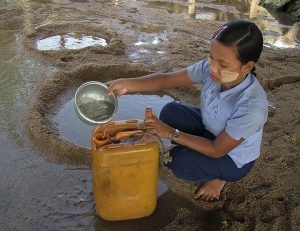During my visit to the Development Affairs Committee Office in Meiktila, its chairwoman told me that ecoline is found in the town’s direct water supply. Ecoline, itself, is not a disease, but diseases can be found with this agent, which is why we need to chlorinate water tanks.
The task of the Development Affairs Department is to supply water to villages throughout the entire nation. So, in the initial stage we are implementing the task of supplying water to villages. In central Myanmar, where water is in short supply, villagers rely on tube-wells. Half-inch or ¾-inche pipes are used in providing water to their homes.
But in certain villages located in the places where rainfall is high, people rarely install of house-by-house piping system. But they need enough clean water for their consumption so that they will be healthy and fit. Most of the water in ponds, lakes or wells is not hygienic. There must be a piped water system even in the villages where rainfall is heavy. But some people do not want to bear the cost of channeling water directly to their homes.
Villagers should have knowledge about the cost of supplying water to their homes. Villages which are located near water sources need not pay for water charges. They need to pay only for transport charges.
Normally, the transport fee of a 50-gallon water barrel is K 500. The cost of one unit of water (one cubic-feet of water or 220 gallons of water) is K 2200. But when the water is transported by their bullock-cart or by human labour, they forget to calculate the cost. In the arid zone, a 50-gallon water barrel cost K 200 at the tube-well. If the transport fee is added the cost will become K 700. It means that one unit of water or one cubic-feet of water or 220 gallons of water costs K 3080. So, a household in the arid zone that buys water at a village-owned tube-well has to pay at least K 46,200 per month. In the cities like Yangon and Mandalay, the bill for a family using 15 units of water per month is just below K 10,000. So villagers are paying a price four times higher than their urban counterparts for water.
When I served in Magway Region from 2013 to 2017, we faced a lot of difficulties in organizing villagers to accept our rural water supply system during the first year. But during the following years, villagers were eager for home water supply system. As the home water supply system was implemented with the department budget, the UNICEF aid, funds of the people centred project and public donations. We could install home water supply system in over 670 villages in 2019. The rural water supply system has less wastage than the urban water supply one, and is easier for controlling the water quality.

As the number of homes in most of the villages is between 80 and 200, it is easier to maintain the rural water supply. Normally, water consumption amount of a village is small. As the villages are using solar pumps, thay have no fuel or electricity cost to get water. So, the price for a unit of water is just K 30 for the rural people.
Most of the tube-wells in Magway Region are over 1000-foot deep. It is one of the places in Myanmar that are difficult to get drinking water. When the total cost for the home water supply system (including the cost of pumps, pipes and fuel) in this region is calculated, it is found that per unit (220 gallons of water) is less than K 200.
So the water bill for a family that uses about 15 units is about K 3000. So the monthly cost for a rural family using water from home water supply system is K 43,000 lesser than a family, which buys water from the village-owned tube-well. As for a year, the bill of the former will be K 516,000 cheaper than the bill of the latter. So, a 100-home village can save up to K 51.6 million within a year. Therefore, 480 villages with home water supply can save K 24.7 billion a year. This calculation is based on ten percent of the villages in Magway Region. If it is for the whole country, we can imagine the amount we can save.
One of the factors that we the Myanmar people become shorter and thinner is that we are not drinking hygienic water. So, it has become a must for us to ensure clean water supply for every home in all the rural areas of the country, where the majority of the population lives. In this way the rural people can get access to clean water at fewer charges. They can also reduce their expense on water. So, home water supply for every village will cut down the expenditure of rural families.
(Translated by TMT)



